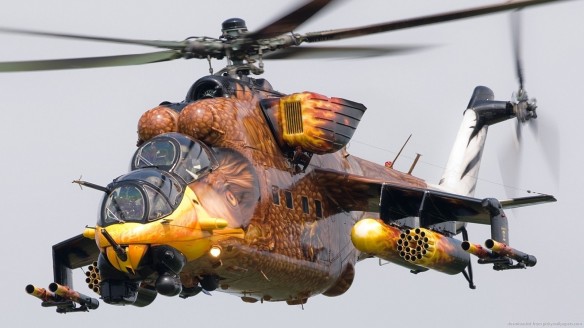
Russian Air Force Mil Mi-24P
First flown in September 1969 and distinctive from the A model, which had side-by-side crew seating, the Hind has tandem seating for pilot and gunner and is heavily armed and armored; later versions have applique armor surrounding crew. Hind C is not equipped with nose gun, and F has wing-mounted gun pods and no nose turret. Specially equipped G models are used for radiation sampling. Tailrotor mounted on port side of vertical fin on later models. Hind 25 and 35 are export versions. More than 2,500 of all variants manufactured and used extensively by USSR in Afghanistan war. Over 2,100 Hinds sold to other countries.
To produce the first model Hind A (NATO designation), Mil modified the fuselage of the Mi-8 but used the same two TV2-117 1,482-horsepower turboshafts and five-bladed main and threebladed tailrotor system of the Hip. Mil installed the retractable tricycle landing gear of the Mi-14 and the antidihedral wings of the Mi-6 for weapon installation. The Hind’s cockpit that went into flight testing in 1970 resembled a World War II bomber, with a multipaned canopy and a 12.7-mm machine gun in the nose. The pilots sat side by side on a four-place bench seat behind the gunner’s position, which resulted in poor visibility. The Hind A carried a crew of three and up to eight combat-loaded troops, who could fire their individual weapons through windows in the cargo compartment. Weapons on the wing stores included four to eight AT-2 Swatter ATGMs and two to four 57-mm rocket pods. If not transporting troops the Hind held four litters and a medic, or carried a second basic load of rockets and missiles internally. The heavily armored Hind A, according to the Mil Bureau, posted a speed record of 198.72 knots during testing. The West first saw the Hind A in Eastern Europe in 1972, with “V” and “C” models appearing in succeeding years.
In 1975, Western intelligence services discovered the radically redesigned Mi-24D. A new stepped tandem cockpit with bulletproof bubble canopies provided greater visibility for the pilot and copilot/ gunner, who sat in the forward cockpit, just behind and above a YaKB-12 four-barreled heavy machine gun mounted in a chin turret capable of a 120-degree traverse. Two Isotov TV-3-117 2,200-horsepower turbines, installed in the upper section of the 57-foot, 8-inch fuselage, powered the all-metal 56-foot, 9-inch main and 12-foot, 9.5-inch tailrotors. With a wingspan of 21 feet, 4 inches, the new Hind exhibited a range of 245 nautical miles with a normal load, and a maximum ceiling of 14,700 feet at a maximum gross weight of 26,455 pounds. Without weapons the aircraft could haul a 5,500- pound slingload. In addition to armored seats, applique armor surrounded the cockpit as well as critical oil and fuel supplies. Wingstores included ATGMs, 57- or 80-mm rocket pods, or free-fall bombs.
The Mi24D began to appear in significant numbers in Soviet units in 1976, and in Warsaw Pact countries shortly afterward. Production records indicated that about fifteen Hinds a month rolled off the Mil assembly lines. At the time the Red Army invaded Afghanistan in 1980, more than 1,000 Mi-24s were in service, and the Hind became a symbol of that war, much like the Huey in Vietnam. Although Mil upgraded the Hind with lighter, more efficient composite rotor blades, yokes, and hubs, aircraft limitations affected the successful employment of the Hind in the rarified air of the Afghan mountains. The wings provided 22 to 28 percent of the helicopter’s lift, requiring pilots to maintain minimum forward airspeeds or the helicopter would experience unmanageable roll rates in tight turns; nor could the heavily loaded machines hover at the high altitudes encountered, sometimes 18,000 feet. Although ruggedly designed, the Hind’s transmission, and especially the tailrotor gearbox, rapidly overheated at a hover without the cooling effect of airflow through cooling vents. As a result, the Hind pilots mimicked U.S. Army tactics from Vietnam and flew in pairs, or multiples of pairs, making running fire attacks on their mujahedeen adversaries. The Hind pilots relied on speed and armor to survive. They attacked at 140 knots, blasted the target area, and pulled away in tight turns.
Soviet tactics overall replicated U. S. tactics in Vietnam. Mi-8 and Mi-17s, escorted by Mi-24s, lifted large numbers of troops to air assault into remote areas to attack mujahedeen soldiers in their sanctuaries. Hind pilots also frequently flew “roadrunner missions,” escorting vulnerable convoys moving along winding mountain roads. Afghani rebels called the Mi-24 the “Devil’s Chariot” because of the heavy firepower the Hind brought to the battlefield. The Hind pilots called themselves “Grey Wolves.” Ground fire downed several other types of helicopters, but the heavily armored Mi-24s remained almost impervious to most weapons, except Rocket Propelled Grenades (RPGs). To escape the volleys of RPGs most Soviet helicopter crews flew at higher altitude until 1985, when the CIA introduced the U. S.-manufactured Stinger missiles through Pakistan. The highly effective Stinger, with a maximum range of 15,000 feet, forced the helicopters back down where small arms again began to take a toll of Soviet aircraft. The rebels claimed that all they needed to defeat the invaders was the Koran and more Stingers. The USSR lost hundreds of aircraft and at least 15,000 aircrewmen in the Afghanistan War. The mujahedeen claimed to have downed more than 200 Mi-24s alone. Several captured Hind crews were skinned alive because of the death and destruction they wrought on rebel villages. In 1987, Soviet engineers equipped their helicopters with flare dispensers, but the Stingers continued to bring down helicopters until the last Soviets departed Afghanistan in February 1989.